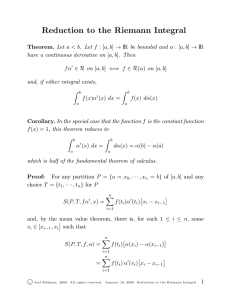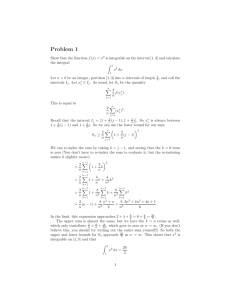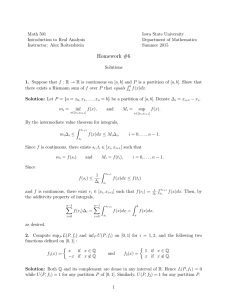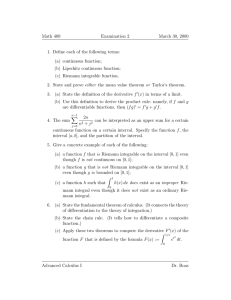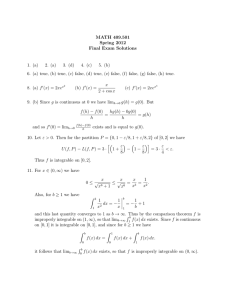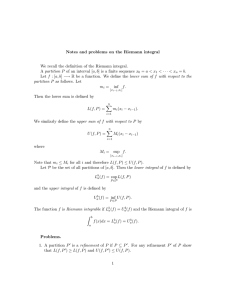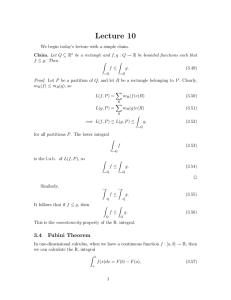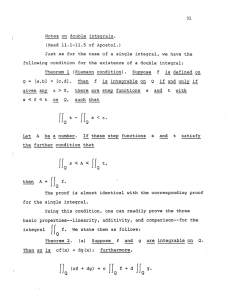Math 1321 (Qinghai Zhang) Summary of §12 Multiple Integrals 2013-MAR-04
advertisement
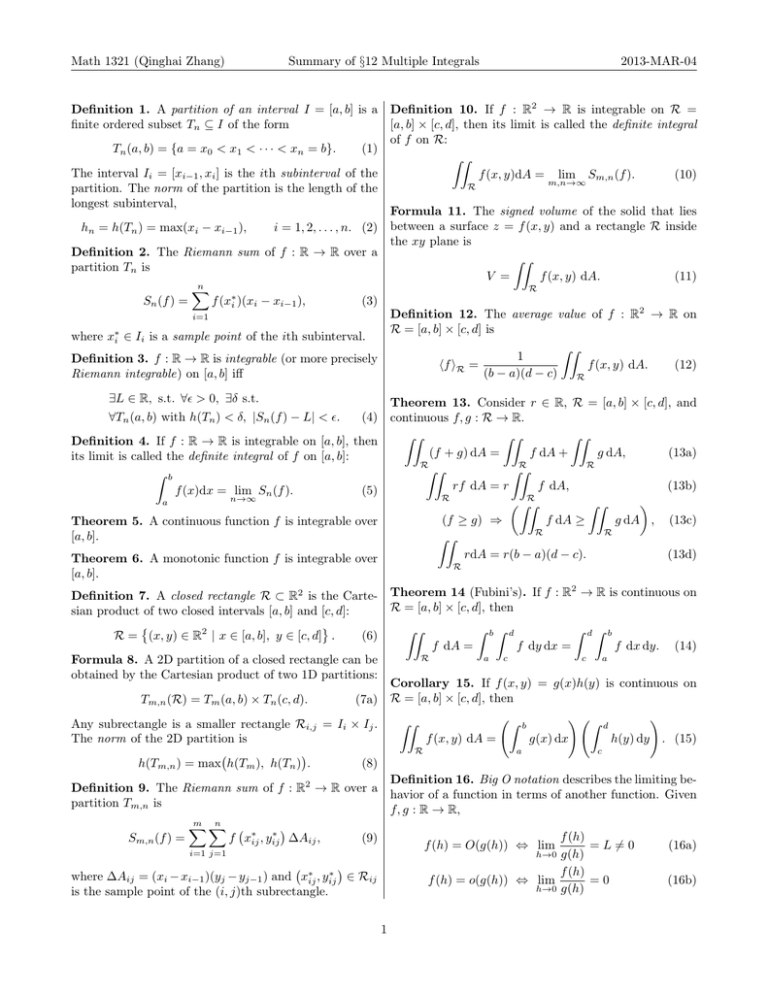
Math 1321 (Qinghai Zhang)
Summary of §12 Multiple Integrals
2013-MAR-04
Definition 1. A partition of an interval I = [a, b] is a Definition 10. If f : R2 → R is integrable on R =
finite ordered subset Tn ⊆ I of the form
[a, b] × [c, d], then its limit is called the definite integral
of f on R:
Tn (a, b) = {a = x0 < x1 < · · · < xn = b}.
(1)
ZZ
The interval Ii = [xi−1 , xi ] is the ith subinterval of the
f (x, y)dA = lim Sm,n (f ).
(10)
m,n→∞
R
partition. The norm of the partition is the length of the
longest subinterval,
Formula 11. The signed volume of the solid that lies
hn = h(Tn ) = max(xi − xi−1 ),
i = 1, 2, . . . , n. (2) between a surface z = f (x, y) and a rectangle R inside
the xy plane is
Definition 2. The Riemann sum of f : R → R over a
ZZ
partition Tn is
V =
f (x, y) dA.
(11)
n
R
X
Sn (f ) =
f (x∗i )(xi − xi−1 ),
(3)
Definition 12. The average value of f : R2 → R on
i=1
R = [a, b] × [c, d] is
where x∗i ∈ Ii is a sample point of the ith subinterval.
ZZ
1
Definition 3. f : R → R is integrable (or more precisely
f (x, y) dA.
(12)
hf iR =
(b − a)(d − c)
Riemann integrable) on [a, b] iff
R
∃L ∈ R, s.t. ∀ > 0, ∃δ s.t.
Theorem 13. Consider r ∈ R, R = [a, b] × [c, d], and
(4) continuous f, g : R → R.
ZZ
ZZ
ZZ
Definition 4. If f : R → R is integrable on [a, b], then
(f
+
g)
dA
=
f
dA
+
g dA,
(13a)
its limit is called the definite integral of f on [a, b]:
R
R
R
ZZ
ZZ
Z b
rf
dA
=
r
f dA,
(13b)
f (x)dx = lim Sn (f ).
(5)
R
R
n→∞
a
Z Z
ZZ
(f ≥ g) ⇒
f dA ≥
g dA , (13c)
Theorem 5. A continuous function f is integrable over
R
R
[a, b].
ZZ
rdA = r(b − a)(d − c).
(13d)
Theorem 6. A monotonic function f is integrable over
∀Tn (a, b) with h(Tn ) < δ, |Sn (f ) − L| < .
R
[a, b].
2
Definition 7. A closed rectangle R ⊂ R2 is the Carte- Theorem 14 (Fubini’s). If f : R → R is continuous on
R = [a, b] × [c, d], then
sian product of two closed intervals [a, b] and [c, d]:
ZZ
Z bZ d
Z dZ b
R = (x, y) ∈ R2 | x ∈ [a, b], y ∈ [c, d] .
(6)
f dA =
f dy dx =
f dx dy. (14)
R
a
c
c
a
Formula 8. A 2D partition of a closed rectangle can be
obtained by the Cartesian product of two 1D partitions:
Corollary 15. If f (x, y) = g(x)h(y) is continuous on
R
= [a, b] × [c, d], then
Tm,n (R) = Tm (a, b) × Tn (c, d).
(7a)
! Z
!
ZZ
Z b
Any subrectangle is a smaller rectangle Ri,j = Ii × Ij .
d
f (x, y) dA =
g(x) dx
h(y) dy . (15)
The norm of the 2D partition is
R
a
c
h(Tm,n ) = max h(Tm ), h(Tn ) .
(8)
Definition 16. Big O notation describes the limiting beDefinition 9. The Riemann sum of f : R2 → R over a
havior of a function in terms of another function. Given
partition Tm,n is
f, g : R → R,
m X
n
X
∗
f (h)
Sm,n (f ) =
f x∗ij , yij
∆Aij ,
(9)
f (h) = O(g(h)) ⇔ lim
= L 6= 0
(16a)
i=1 j=1
h→0 g(h)
f (h)
∗
where ∆Aij = (xi − xi−1 )(yj − yj−1 ) and x∗ij , yij
∈ Rij
f (h) = o(g(h)) ⇔ lim
=0
(16b)
h→0
g(h)
is the sample point of the (i, j)th subrectangle.
1
Summary of §12 Multiple Integrals
Math 1321 (Qinghai Zhang)
2013-MAR-04
Formula 17 (Midpoint rule for a double integral).
If f : R2 → R is C 3 over a rectangle R, then
Theorem 23 (Change of variables in a double integral).
Consider a C 1 , bijective function F : S → D that maps a
region S ⊂ R2 in the u-v plane to another region D ⊂ R2
ZZ
m X
n
X
in the x-y plane. If both S and D are regular, then for a
f (x, y) dA =
f (x̄i , ȳj ) ∆Aij + O h4m,n ,
continuous
f : D → R,
R
i=1 j=1
Z
Z
ZZ
(17)
f (x, y) dA =
f x(u, v), y(u, v) det(JF ) dudv.
where hm,n is the norm of the 2D partition (7a), and
D
1
ȳj = (yj−1 + yj ).
2
1
x̄i = (xi−1 + xi ),
2
S
(24)
(18)
Definition 24. In the polar coordinate system, the position of each point P on the Euclidean plane is deterDefinition 18. A planar region D is regular if it can be
mined by r = |P − O|, its distance from the origin O,
described in either of these two ways
and θ, the angle between the two vectors P − O and i.
The relations between the polar coordinates (r, θ) and
Type I. D = (x, y) | x ∈ [a, b], y ∈ [g1 (x), g2 (x)] ;
the Cartesian coordinates (x, y) are
Type II. D = (x, y) | y ∈ [c, d], x ∈ [h1 (y), h2 (y)] .
x = r cos θ,
(25)
Theorem 19. If f is continuous on a regular region D,
y = r sin θ.
then its double integral can be calculated by an iterated
Corollary 25. If f (x, y) is continuous on the polar rectintegral :
angle
#
ZZ
Z b "Z g2 (x)
f (x, y) dA =
f (x, y) dy dx, (19a)
D = {(r, θ) | 0 ≤ a ≤ r ≤ b, 0 ≤ α ≤ θ ≤ β ≤ 2π}, (26)
D
a
ZZ
Z
g1 (x)
"
d Z
f (x, y) dA =
D
f (x, y) dx dy.
c
then its double integral over D can be calculated as
#
h2 (y)
(19b)
ZZ
h1 (y)
Z
β
Z
b
f (x, y) dA =
D
f (r cos θ, r sin θ) rdr dθ. (27)
α
a
Theorem 20. If (i) D1 ∩ D2 is empty or only contains
boundary points of D1 and D2 , (ii) f : R2 → R is con- Formula 26. If the density function ρ(x, y) is continutinuous on D = D1 ∪ D2 , then
ous for a lamina D, then the mass of the lamina is given
ZZ
ZZ
ZZ
by
ZZ
f dA =
f dA +
f dA.
(20)
m=
ρ(x, y) dA,
(28)
D
D1
D2
D
its moments about the x-axis and y-axis by
ZZ
ZZ
Mx =
yρ(x, y) dA, My =
xρ(x, y) dA, (29)
Definition 21. A function f : X → Y is said to be
injective or one-to-one iff
∀x1 ∈ X, ∀x2 ∈ X, x1 6= x2 ⇒ f (x1 ) 6= f (x2 ). (21)
D
its center of mass (x̄, ȳ) by
It is surjective or onto iff
∀y ∈ Y, ∃x ∈ X, s.t. y = f (x).
D
x̄ =
(22)
It is bijective iff it is both injective and surjective.
My
,
m
ȳ =
Mx
,
m
(30)
its moment of inertia about the x-axis and y-axis by
ZZ
ZZ
Definition 22. The Jacobian maxtrix of a function
2
Ix =
y ρ(x, y) dA, Iy =
x2 ρ(x, y) dA. (31)
F : R2 → R2 given by x = x(u, v), y = y(u, v) is
D
D
Formula 27. If σ(u, v) = hx(u, v), y(u, v), z(u, v)i is
∂x
∂x
(23) C 1 and is injective on D, then the area of the surface
JF = ∂u ∂v ,
∂y
∂y
S = {P | P = σ(u, v), (u, v) ∈ D} is
∂u
∂v
ZZ ∂σ ∂σ and det(JF ) is the Jacobian (or more precisely Jacobian
dA.
A(S) =
×
(32)
∂v determinant).
D ∂u
2

